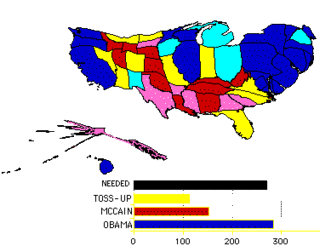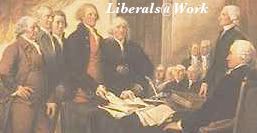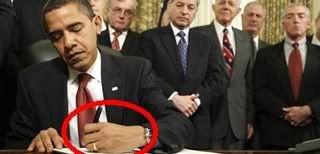
Resurrecting the the electoral maps I used in 2004 to measure what the state of the race is now got me wondering if any new work had been done along these lines. The first place to start, naturally was my archives at my old Blogdrive blog to trace back this "cartogram" to its creator, Geography Professor Dr. Sara Fabrikant at UC Santa Barbara, who looked at the maps of the US colored red and blue on her television (mostly red) the day after the 2000 election and couldn't understand how the pundits could call the race close, even though it was oh, so damn close. Yet the map was a sea of red.
The problem of course was that every news outlet took maps designed to show relative geographical data and used those very familiar metaphors for reality and tried to use them for a completely different purpose, counting up electoral votes. As I indicated in my post below, although the pundits are again calling this a close race, if you map people and potential electoral college votes rather than the geography of the USA, the picture becomes clearer that John McCain is in a world of hurt.
Dr. Fabrikant and a colleague were interviewed by the Santa Barbara Press right after the 2004 election, and explained their vision of the political landscape.
"The best representation of what kind of a nation we really are, contrary to the simplistically divided red vs. blue, selling Tide and Superglue country the corporate media will perpetuate for as long as they have breath, is Dr. Fabrick's county-by-county cartogram that not only distorts the geography to show population more accurately, but also shades each county varying degrees of purple based on their support for Bush or Kerry last time around.It's actually communicating information about acres, not voters," said Daniel Montello, a UCSB geography professor.
All maps are distortions of reality, said Mr. Montello, who studies how people perceive space and geography. The earth is round and land masses are difficult to accurately draw on a two-dimensional plane. But different maps serve different purposes.
For Mr. Montello, who has a doctorate in psychology and serves as the chairman of the university's Cognitive Science Program, the meaning a map conveys is important.
The red of giant western states like Wyoming, with its population of less than 500,000, dominates the electoral map used by most newspapers.
But try and find the blue dot of the District of Columbia, which has close to 600,000 people. There are more people in a few blocks of New York City than the whole state of North Dakota, but you would probably have an easier time finding Bismarck than the Bronx in most of the national maps used to chart the election.
There are some notable exceptions to that rule. Both the New York Times and the Los Angeles Times this week have included different maps to chart such things as the depth of support for each candidate in each county across the nation. And both papers have included maps that distort the shape of states, enlarging and shrinking them based on their electoral votes.
It is ironic that distorted maps can actually convey more meaning than the standard representations of the United States, said Sara Fabrikant, a geography professor at UCSB.
Ms. Fabrikant created her first election map the day after the 2000 presidential election. The Swiss native wanted to understand the close race. She was perplexed by the message that the election was too close to call, yet the election maps used on television and in the newspapers showed a nation colored mostly Republican red.
"I'm not an American citizen and I didn't understand the electoral vote system until I put it on a map," she said.
The traditional political map made it appear that President Bush was winning hands down.
"In essence they are using the wrong visual form," Ms. Fabrikant said.
Using cartograms, maps that include statistical data to add color shading or distortions in shape, she created a map based on electoral votes that showed a more even split in votes between candidate Al Gore and Mr. Bush in the 2000 race.
She did it again this year, posting her maps online the day after the race.
The distorted maps range in color from a light blue to light pink, showing both the intensity of support for each candidate and the relative number of votes each got. (One of her colleagues said the distorted national map looks slightly like an upsidedown donkey, but Ms. Fabrikant said it was pure coincidence and that she has no party affiliation.)
"What you can really see is the urban and rural contrast in voting," Ms. Fabrikant said.
The cartogram contracts the empty land and expands the populated cities.
Over the summer she delivered a paper on the 2000 race, "Blue & Red America," to a group of German academics. She's also added other variables to her maps and included a breakdown by county. What's striking is that displaying the data in different ways begs new questions. On one map she included major rivers and highways and found a line of blue snaking up the Mississippi. In another she saw an arching band of blue extending through several southern states.
The apparent patterns prompted her to wonder if the lines followed the same migration routes of blacks who moved north for jobs, or whether they simply follow urban development along the river front. Ms. Fabrikant said she would like to work more with a political scientist to investigate those patterns.
Making these maps isn't about politics, she said, but communicating information.
"Basically what has been driving cartography for 5,000 years is the acknowledgement that a picture really is worth a thousand words."
Nothing proves Barack Obama's point better than this map. There are no red States and there are no blue States. We are one big purple nation, a country of fabulous color.
 Exposing the lack of compassion by conservatives and
debunking right wing hypocrisy at every opportunity.
Exposing the lack of compassion by conservatives and
debunking right wing hypocrisy at every opportunity.






 Subscribe via Email
Subscribe via Email
0 Comments:
POST A COMMENT